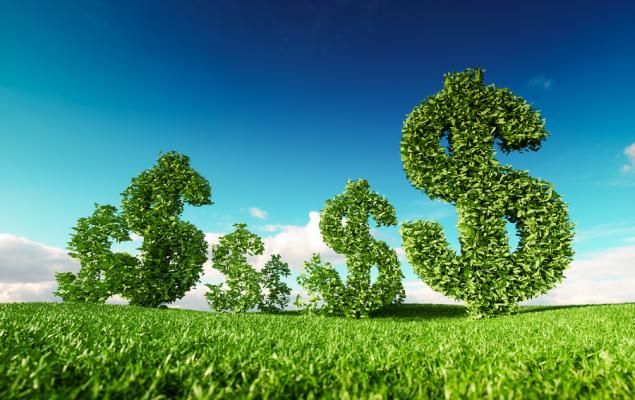
“Climate change is the biggest threat to our planet,” said Amazon’s (AMZN) CEO, Jeff Bezos, in an Instagram post, in which he informed about the Bezos Earth Fund to counter climate-change risks. The world’s richest man has pledged $10 billion for the cause. Amazon has also pledged to go carbon neutral by 2040 and install 100,000 electric delivery vans by 2024. This is another example of how climate-change risks are gaining increasing attention from companies, investors, financial institutions and asset managers.
<p class="canvas-atom canvas-text Mb(1.0em) Mb(0)–sm Mt(0.8em)–sm" type="text" content="Climate-change risk was added to the final communique for the first time during Trump’s tenure as a president by the finance ministers from the world’s 20 biggest economies (G20) in Riyadh, Saudi Arabia. Moreover, the U.S. security, military and intelligence experts released a warning on Feb 24 about the High-to-Catastrophic threats to global security from climate changes, in a report released by the “National Security, Military and Intelligence Panel (NSMIP)” of the Center for Climate and Security. This report highlights how it has become the need of hour to prudently cut the emission of greenhouse gases. In fact, the global investment bank — JPMorgan — has committed to facilitate about $200 billion of transactions that “support climate action and also work toward the United Nations’ sustainable development goals in 2020”. The bank also aims to expand limitations on financing coal mining, coal-fired power and Arctic drilling.” data-reactid=”19″>Climate-change risk was added to the final communique for the first time during Trump’s tenure as a president by the finance ministers from the world’s 20 biggest economies (G20) in Riyadh, Saudi Arabia. Moreover, the U.S. security, military and intelligence experts released a warning on Feb 24 about the High-to-Catastrophic threats to global security from climate changes, in a report released by the “National Security, Military and Intelligence Panel (NSMIP)” of the Center for Climate and Security. This report highlights how it has become the need of hour to prudently cut the emission of greenhouse gases. In fact, the global investment bank — JPMorgan — has committed to facilitate about $200 billion of transactions that “support climate action and also work toward the United Nations’ sustainable development goals in 2020”. The bank also aims to expand limitations on financing coal mining, coal-fired power and Arctic drilling.
<p class="canvas-atom canvas-text Mb(1.0em) Mb(0)–sm Mt(0.8em)–sm" type="text" content="ETFs to Combat Climate Change” data-reactid=”20″>ETFs to Combat Climate Change
To gain from this trend of considering climate-change risks while building portfolio, investors can focus on alternative energy funds and/or environmental, social and governance (ESG) investing strategy. Below we discuss a few ETFs that can help our investors build a climate-change risk-proof portfolio:
<p class="canvas-atom canvas-text Mb(1.0em) Mb(0)–sm Mt(0.8em)–sm" type="text" content="Xtrackers MSCI USA ESG Leaders Equity ETF USSG ” data-reactid=”22″>Xtrackers MSCI USA ESG Leaders Equity ETF USSG
The fund tracks the investment results that correspond generally to the performance of the MSCI USA ESG Leaders Index. The fund has an AUM of $1.70 billion. It charges 10 basis points (bps) in fees (read: Most Interesting New ETFs).
<p class="canvas-atom canvas-text Mb(1.0em) Mb(0)–sm Mt(0.8em)–sm" type="text" content="Vanguard ESG U.S. Stock ETF ESGV” data-reactid=”24″>Vanguard ESG U.S. Stock ETF ESGV
The fund tracks the performance of the FTSE US All Cap Choice Index comprising large-, mid-, and small-capitalization stocks. The fund has an AUM of $1.05 billion. It charges 12 bps in fees (read: Best Thematic ETFs for 2020).
<p class="canvas-atom canvas-text Mb(1.0em) Mb(0)–sm Mt(0.8em)–sm" type="text" content="iShares ESG MSCI USA ETF ESGU” data-reactid=”26″>iShares ESG MSCI USA ETF ESGU
The fund seeks similar risk and return to the MSCI USA Extended ESG Focus Index, while achieving a more sustainable outcome. The fund has an AUM of $3.52 billion. It charges 15 bps in fees (read: Are ESG ETFs the Right Choice for 2020?).
<p class="canvas-atom canvas-text Mb(1.0em) Mb(0)–sm Mt(0.8em)–sm" type="text" content="Nuveen ESG Large-Cap Growth ETF NULG” data-reactid=”28″>Nuveen ESG Large-Cap Growth ETF NULG
The underlying TIAA ESG USA Large-Cap Growth Index comprises large-cap equity securities, and meet ESG criteria and exhibit overall growth style characteristics based on long-term forward EPS growth rate, short-term forward EPS growth rate, current internal growth rate, long-term historical EPS growth trend & long-term historical sales per share growth trend. The fund has an AUM of $148.4 million. It charges 35 bps in fees (read: ESG ETFs: Doing Well And Doing Good).
<p class="canvas-atom canvas-text Mb(1.0em) Mb(0)–sm Mt(0.8em)–sm" type="text" content="Invesco Solar ETF TAN” data-reactid=”30″>Invesco Solar ETF TAN
The fund is based on the MAC Global Solar Energy Index, which comprises companies from the solar energy industry. The fund’s AUM is $642.4 million and the expense ratio is 0.71% (read:Why Clean Energy ETFs Are Shining).
<p class="canvas-atom canvas-text Mb(1.0em) Mb(0)–sm Mt(0.8em)–sm" type="text" content="iShares Global Clean Energy ETF ICLN” data-reactid=”32″>iShares Global Clean Energy ETF ICLN
The fund provides exposure to companies that produce energy from solar, wind, and other renewable sources and tracks the S&P Global Clean Energy Index. The fund’s AUM is $671.5 million and the expense ratio is 0.46%.
<p class="canvas-atom canvas-text Mb(1.0em) Mb(0)–sm Mt(0.8em)–sm" type="text" content="Invesco WilderHill Clean Energy ETF PBW” data-reactid=”34″>Invesco WilderHill Clean Energy ETF PBW
The fund is based on the WilderHill Clean Energy Index. It has an AUM of $343.3 million and charges an expense ratio of 0.70% (read: Sector ETFs at the Midpoint in Q1: Hits & Misses).
<p class="canvas-atom canvas-text Mb(1.0em) Mb(0)–sm Mt(0.8em)–sm" type="text" content="Invesco Cleantech ETF PZD” data-reactid=”36″>Invesco Cleantech ETF PZD
It is based on the Cleantech Index. The fund’s AUM is $252.9 million and the expense ratio is 0.67% (read: Top ETF Areas for 2020).
<p class="canvas-atom canvas-text Mb(1.0em) Mb(0)–sm Mt(0.8em)–sm" type="text" content="Want key ETF info delivered straight to your inbox?” data-reactid=”38″>Want key ETF info delivered straight to your inbox?
<p class="canvas-atom canvas-text Mb(1.0em) Mb(0)–sm Mt(0.8em)–sm" type="text" content="Zacks’ free Fund Newsletter will brief you on top news and analysis, as well as top-performing ETFs, each week. Get it free >>” data-reactid=”39″>Zacks’ free Fund Newsletter will brief you on top news and analysis, as well as top-performing ETFs, each week. Get it free >>











Add Comment